Taisei Holdings Group Progress


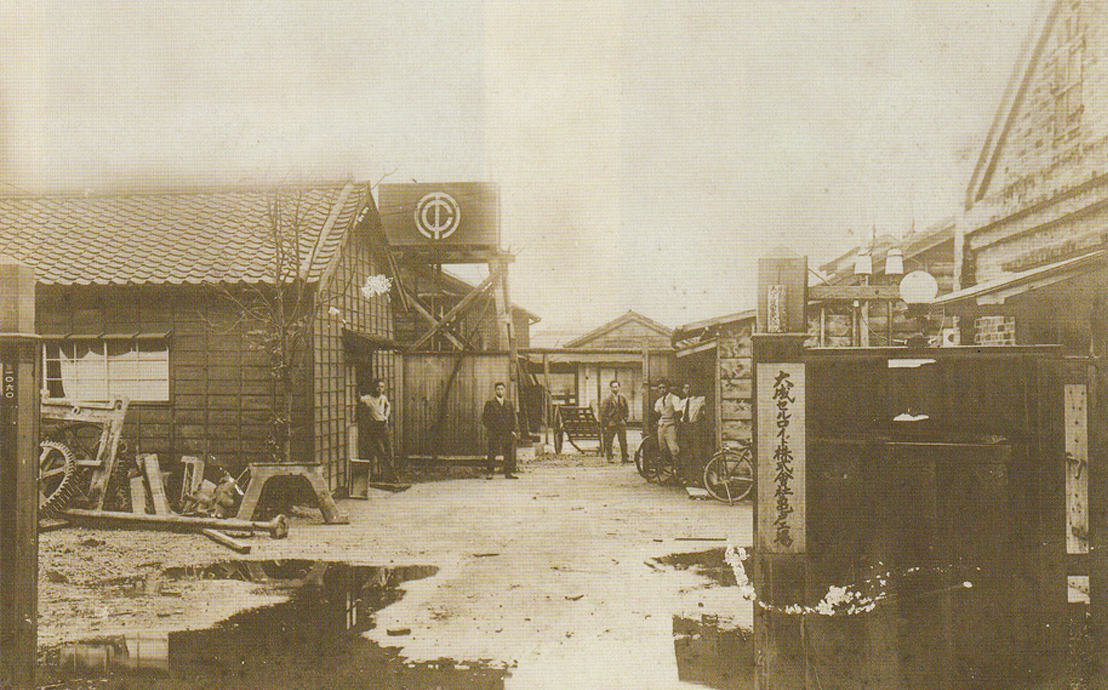
It can be said that the history of Taisei Group started in 1914.Still, we could go back to 1914 when Jisaburo Fukami, one of the founders, launched the Fukami Celluloid Factory in Kameido Town, Minami-Katsushika County, Tokyo (Kameido Town, Koto Ward, Tokyo at present) to start manufacturing raw materials of recycled celluloid, which was the first step of the Taisei Group into the celluloid industry.This was also the first step into the chemical industry for the Taisei Group.
In those days, only recycled celluloid manufacturers existed in the Kanto region; no companies manufactured newly produced celluloid from cellulose nitrate. We completed the Kameido Factory to construct the first newly produced celluloid factory in the Kanto region, using the latest facilities for producing cellulose nitrate then, which was called the Hyatt type.In 1925, Taisei Celluloid Co., Ltd. was established in Nihonbashi, Tokyo.This was the first step of our history of almost 100 years.
Photo: Fukami Celluloid Factory in 1914
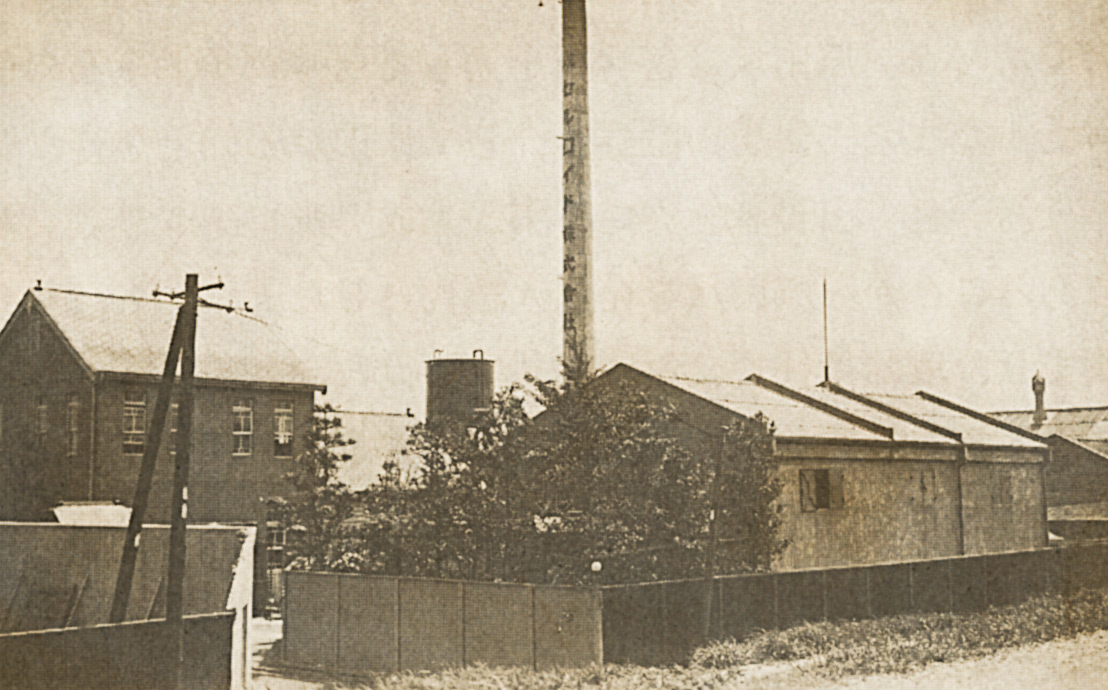
Moving on from our achievements as a pioneering manufacturer, we supplied raw materials and also diversified into selling our own products. In 1935, we expanded to the Okudo Factory and additionally built a coating factory to start producing collodion, pyroxylin lacquer coating materials and oil paint, which was the starting point for our coating business.
Collodion is a cellulose coating and was produced by dissolving cellulose nitrate into an ether alcohol solution.This coating was different from general coatings, and was provided for special purposes, such as coating on Japanese paper cords used for imitation Panama hats that were popular then and coating on cuts as a liquid adhesive plaster.
Photo: Taisei Celluloid Co., Ltd., Okudo Factory in 1928
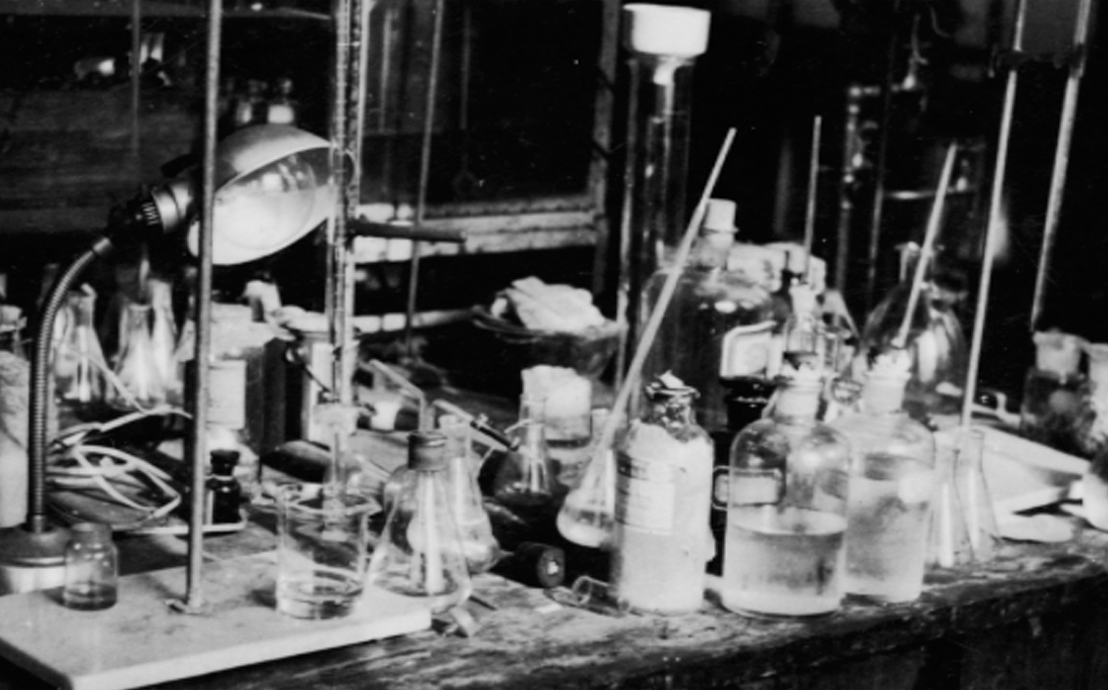
The production amount of celluloid, which had the demerits of being easy to burn and dent, peaked in 1954, the highest since WW II, and then the demand decreased immediately after 1955.The demand shifted from celluloid to plastics and we started to develop resin coating.We developed alkyd resin coating in 1956 and started research on acrylic solution resin for coating in 1959 in a small laboratory.This was the start of the present liquid resin business.
Our work went into revitalizing the celluloid business that was our fundamental business, i.e. advanced utilization of cellulose nitrate concurrent with the conversion to plastics.We focused on manufacturing color chips whose raw material was cellulose nitrate.The manufacturing work also allowed the nonoperating facilities for celluloid manufacturing to be utilized, which overcame the celluloid decline.
On the other hand, we made a project team in the field of resin coating to steadily promote the conversion from celluloid business and cellulose nitrate business.We formed a project team in resin coating to steadily promote converting from celluloid and cellulose nitrate. Rack Zoll, our first alkyd resin coating, was ordered even in the test stage, and our test plant became a manufacturing plant as it was.In addition, Acrit, our acrylic solution resin, also became popular and our group entered a new era.
Photo: Inside of the laboratory, December 1953
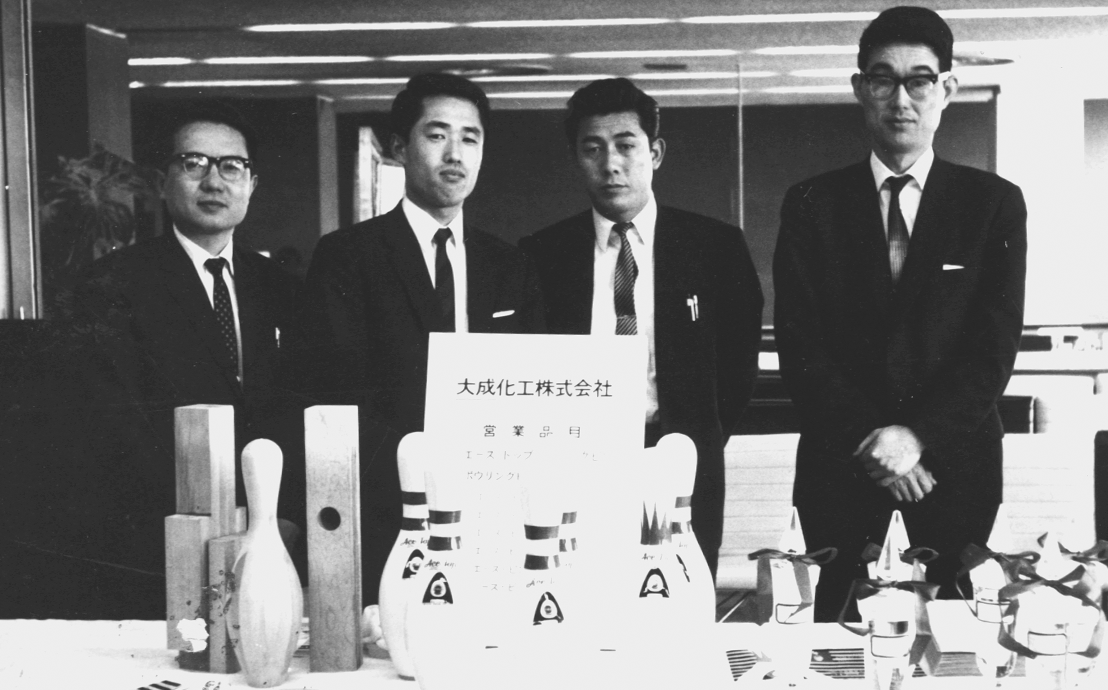
After WW II, US military bases were built around Japan and bowling alleys were built on the bases. These were the first bowling alleys in Japan.Japan's first bowling alley was built in Aoyama, Tokyo, in 1952; the Intercollegiate Bowling Association of Japan was established in 1953. In 1969, female professional bowlers started in Japan, bringing the bowling boom to its peak.A professional bowler, Ritsuko Nakayama, achieved the first official perfect game about that time.
A bowling pin is made of wood inside and a durable coating is applied outside. Every pin was exported in those days.The pins damaged by impact piled up in the machine rooms behind the lanes.We focused our attention on this matter, considered if our coating technique could be used for it and embarked on the bowling pin business.In 1964, we managed to manufacture our original pin, the Ace Top, that acquired certification from the JBC (Japan Bowling Congress).The monthly production amount of the Ace Top reached as many as 10,000 at the peak.
In 1963, we determined the three management philosophies of the Taisei Group that have been passed down unbroken from generation to generation until this day.These philosophies are expressed in simple words to place the principle that we should be a company contributing to society, which the 7th president, Shinji Tokukura, always had in his heart, into every employee's mind.
Photo: Ace Top exhibition in 1967
Celluloid production discontinued in 1967
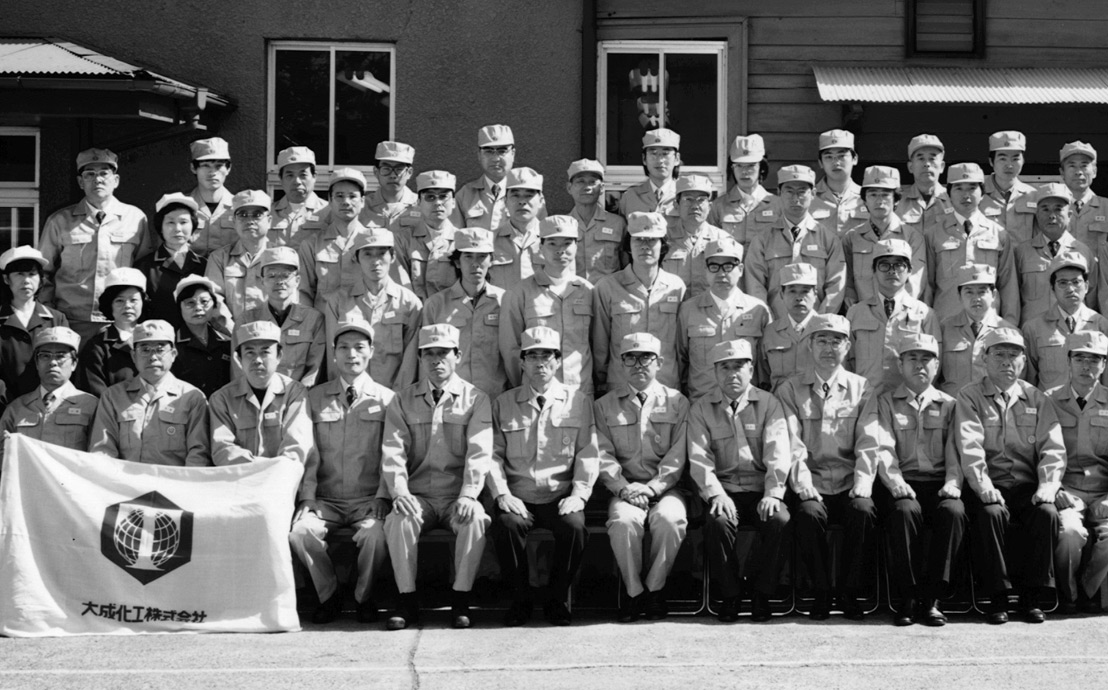
Our group, which has worked hard in chemistry to develop new fields and improve technology, has applied for many patents since we were established.Our first patent application was regarding coating material composition for polishing paper surface in 1976 and was registered in 1987.
We have applied for 62 patents. One special patent among them, applied for in 1986 and registered in 1996, was the vermin attraction inhibiting agent (dye is used as a coloring agent) that was a joint patent with Ikari Shodoku Co., Ltd.We even acquired the patent for this in the US in 1990, which led to the patent acquisition of vermin attraction inhibiting glass in 1997.
Photo: Commemorative photo of new Taisei Kako Co., Ltd.
Bowling pin production and sales discontinued in 1973
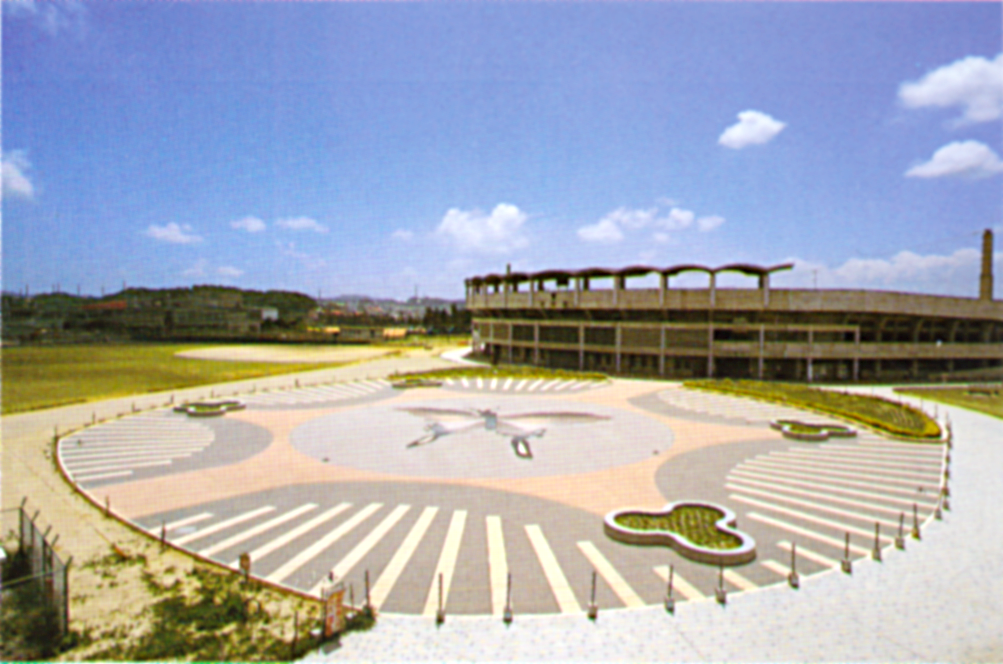
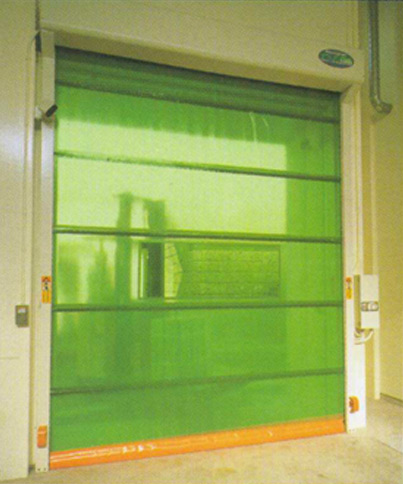
Thinking about how much we could enlarge the potential of coatings led our group to become interested in waterproof coating and to independently advance research and development. We succeeded in developing a flexible urethane prepolymer that was a hardener for an acrylic polyol coating in 1982 and started sales of a waterproof coating in 1983.
The application of this waterproof coating allowed us to develop a coating for tennis courts.Until then, coatings for tennis courts were polyester and poor for weatherproofing; they easily deteriorated or peeled off.Our new product completely overcame those problems.In addition, the coating was applied to running tracks. Our coatings have been applied to many tracks up to the present because of their cushioning property that is kind to athletes' legs.
We also expanded into landscape paving materials. Tosui (moisture curable composition) developed in 1992 allows for beautiful coloring and design and has been highly evaluated as a paving material at tourist sites.
In 1985, we participated in the Tokyo Metropolitan Inter-Industry Exchange Plaza 1960 with the intention of developing products directly connected to consumers and met Ikari Shodoku Co., Ltd. there, which led us to cooperative research.We then completed the Insect Screen that was an epoch-making, insect-repelling and light-shielding coating to defend from light-attracted insects that were formerly intractable, even by insect control professionals, using our technique to control the light wavelength with color tones.After that, we progressed, cooperatively developing one product after another with Ikari Shodoku Co., Ltd., using this insect control mechanism and then developing window sticking films, fluorescent lamps, partition curtains and shutters. The shutters were the fruition of three companies as Komatsu Electric Industry Co., Ltd. also joined us. At present, these products are significantly contributing to the sanitation control of food-related factories as the Optron Insect Control System.
Photo:Top: Construction example of Tosui AcryArt/Ballpark at Chatan Park, Okinawa Prefecture 1993/Bottom: Optron gatekeeper
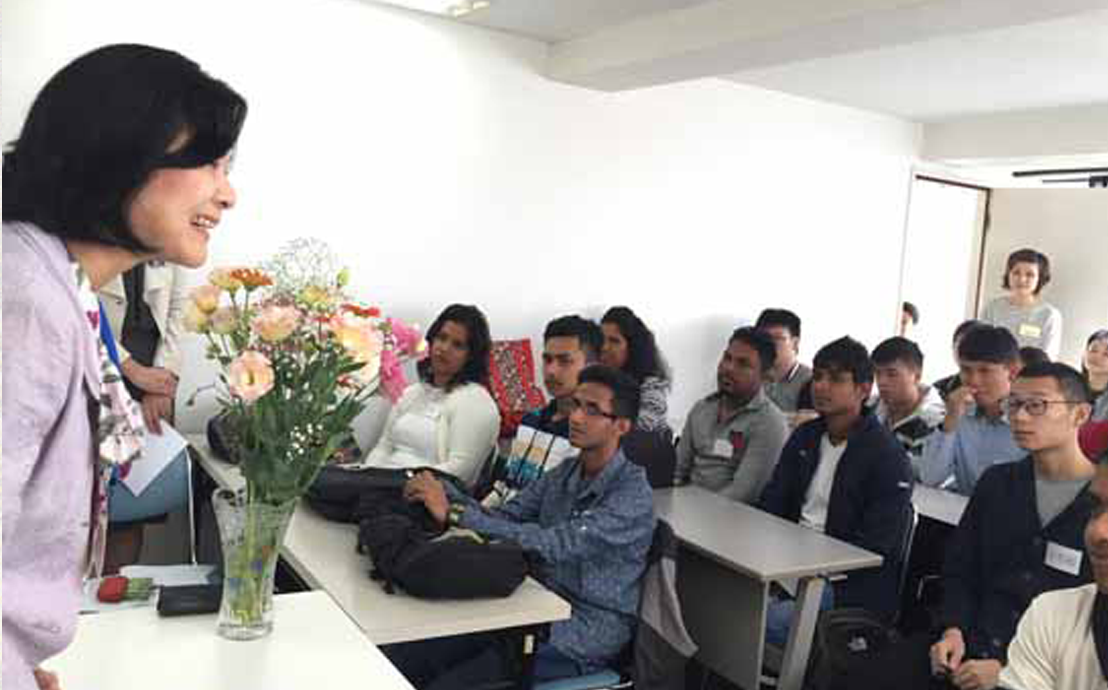
Japan reached the wave of radical internationalization experienced for the first time.The wave included politics, business and familiar living scenes in offices and local societies. In such daily life, we saw many people from abroad more often.Under such an environment, the number of people coming to Japan for study and business would increase more and more.
People coming to Japan can learn Japanese to suit their own purposes and live in Japan.They can depart from Japan with favorable feelings toward Japan when they return to their countries.Moreover, Japan can contribute to international society through the relationship with people from abroad coming to Japan.We established TIJ, the Tokyo Institute of Japanese, in 1991 on the basis of the ideals mentioned above.
This institute enables learners to assimilate Japanese and the manners based on Japanese culture.As the result of evaluating our educational policy, a wide variety of enterprises requested we provide training.We also go beyond courses for people who would like to learn Japanese to offering a course for people who would like to be Japanese language teachers. Other courses are also available.
In the 2000s, our business content that had expanded over a period of 75 years became complicated and complex.Thus, we separated the company into specialized fields to renovate our organization and deeply pursue specialization.
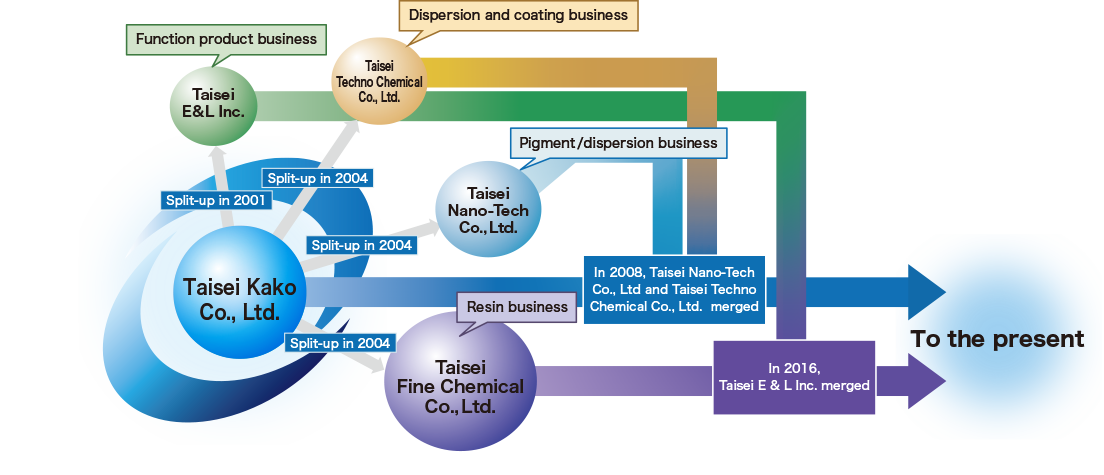
2001年
Our landscape and environment business split off as Taisei E & L Inc. (in 2016, it was absorbed and merged into Taisei Fine Chemical Co., Ltd.)
2004
Our resin business became Taisei Fine Chemical Co., Ltd.
Our dispersion business became Taisei Nano-Tech (in 2008, it was absorbed and merged into Taisei Kako Co., Ltd.)
Our coating business became Taisei Techno Chemical Co., Ltd. (in 2008, absorbed and merged into Taisei Kako Co., Ltd.)
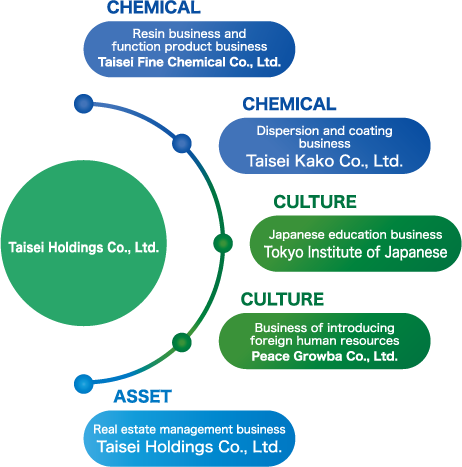
We have repeated commencement of business and withdrawal of business since our establishment as a company in 1925, and we finally celebrated the 90th anniversary of our founding in January 2015.
We shifted into a holdings system in April 2017 with the aim of being a sustainably developing company for more than 100 years by responding to changes in the world in future, and took the first step again just now.
What we aim at in the new system is sharper market sensitivity, quicker decision-making, and provision of newly valued goods and services.
In 2025, our company will mark the 100th anniversary of foundation, and we believed that we went back to our original intention afresh and we should aim at the next 100 years. Therefore, we have organized our foudation spirit by merging our corporate culture continuously inherited since our foundation with the management philosophy prescribed in 1963 that is "letting the company be helpful to the world", "treating people with consideration", and "thoroughly considering and carrying out with fun and pleasantness." we will develop our business that is helpful to our customers and the world based on this spirit.